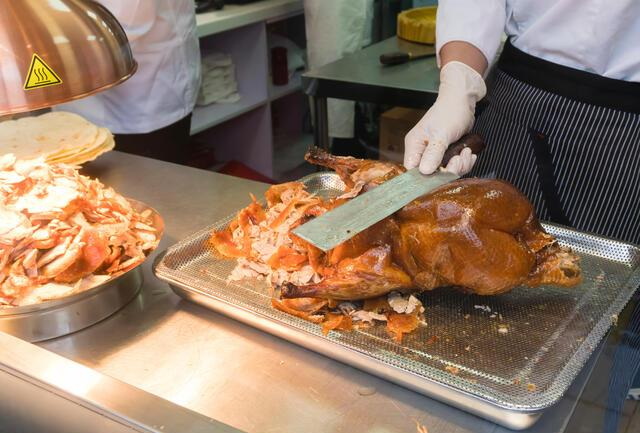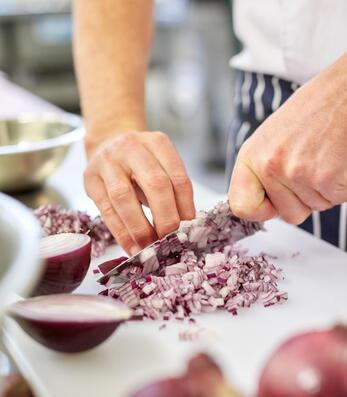

Views: 800 Author: sales@insightknife.com.cn Publish Time: 2025-01-13 Origin: Site








Content Menu
● Understanding Blade Thickness
>> Why Does Blade Thickness Matter?
● The Impact of Blade Thickness on Sharpness
>> How Thickness Affects Sharpness
● The Role of Blade Thickness in Cutting Performance
>> Performance in Different Tasks
● Choosing the Right Blade Thickness
>> Personal Preference and Cooking Style
● Frequently Asked Questions regarding Chef Knife Blade Thicknesses
>> 1. What is the ideal blade thickness for a chef knife?
>> 2. How does blade thickness affect the weight of a knife?
>> 3. Can a thicker blade be sharpened to a fine edge?
>> 4. What are the maintenance differences between thick and thin blades?
>> 5. How does blade thickness influence cutting technique?
When it comes to kitchen knives, particularly chef knives, the blade thickness plays a crucial role in determining sharpness and cutting performance. Understanding how different blade thicknesses affect these factors can help both professional chefs and home cooks make informed decisions about their kitchen tools. This article will explore the relationship between blade thickness, sharpness, and cutting performance, focusing on chef knives.
Blade thickness refers to the measurement of the blade from the spine (the top edge) to the cutting edge. This dimension can significantly influence how a knife performs in various culinary tasks. Chef knives typically have a blade thickness ranging from 1.5 mm to 3 mm, with most falling between 2 mm and 2.5 mm. The choice of thickness is not merely a matter of aesthetics; it directly impacts the knife's functionality and suitability for different types of food preparation. A thicker blade may be more robust, but it can also be less agile, affecting how easily it can navigate through various ingredients.
The thickness of a knife blade affects its weight, balance, and cutting ability. Thicker blades tend to be more durable and can withstand more force, making them suitable for heavy-duty tasks such as chopping through bones or dense vegetables. Conversely, thinner blades are often sharper and can slice through food more easily, making them ideal for precision tasks like filleting fish or slicing delicate fruits. The choice of blade thickness can also influence the overall cooking experience, as a well-chosen knife can enhance efficiency and enjoyment in the kitchen.

Sharpness is the ability of a knife to cut through food with minimal effort. It is determined by the angle of the edge and the thickness of the blade. A sharper knife requires less force to cut, which can enhance safety and efficiency in the kitchen. Sharpness is not just about the initial edge; it also involves how well the knife maintains that edge over time. A knife that dulls quickly can lead to frustration and increased risk of accidents, as users may apply more force than necessary, leading to slips and cuts.
Edge Geometry: Thinner blades can achieve a sharper edge because they can be ground to a finer angle. This allows for a more acute cutting edge, which can slice through food with less resistance. The geometry of the edge is crucial; a thinner edge can penetrate food more easily, reducing the effort required for cutting tasks. This is particularly beneficial when working with soft or delicate ingredients that can be easily crushed by a thicker blade.
Material Removal: When sharpening a knife, the amount of material removed from the blade can affect its thickness. Thinner blades may require more frequent sharpening to maintain their edge, while thicker blades can retain their sharpness longer due to their sturdier construction. This means that while a thinner blade may provide superior initial sharpness, it may also demand more maintenance, which can be a consideration for busy cooks who prefer low-maintenance tools.
Cutting Performance: A sharp knife is essential for effective cutting. Thinner blades can slice through delicate items like tomatoes or fish with ease, while thicker blades may crush or tear these foods instead of slicing cleanly. The performance difference can be stark; for instance, a thin blade can create clean, precise cuts that enhance the presentation of a dish, while a thicker blade may leave jagged edges that detract from the overall aesthetic.
Slicing: For tasks that require precision, such as slicing vegetables or fish, a thinner blade is often preferred. The reduced thickness allows for clean cuts without damaging the food. This is particularly important in professional kitchens where presentation matters, as well as in home cooking where the visual appeal of a dish can enhance the dining experience.
Chopping: When chopping through tougher items like root vegetables or meats, a thicker blade can provide the necessary strength and durability. The added weight of a thicker knife can also help in delivering more force with less effort. This can be especially advantageous when preparing large quantities of food, as the efficiency gained from using a robust knife can save time and energy.
Dicing and Mincing: In tasks that require repetitive motion, such as dicing onions or mincing garlic, a medium-thickness blade strikes a balance between sharpness and durability. It can handle the demands of these tasks without becoming dull too quickly. A well-balanced knife in this context can reduce fatigue, allowing cooks to work more comfortably and efficiently over extended periods.
The thickness of a knife also affects its balance and control during use. A well-balanced knife feels comfortable in hand and allows for better control while cutting. Thicker blades may feel heavier, which can be beneficial for certain tasks but may lead to fatigue during prolonged use. Conversely, thinner blades can feel lighter and more agile, making them easier to maneuver for intricate cuts. The balance of a knife is a personal preference; some cooks may prefer the heft of a thicker blade, while others may favor the nimbleness of a thinner one.

When selecting a chef knife, personal preference and cooking style play significant roles in determining the ideal blade thickness. Chefs who frequently engage in delicate tasks may prefer a thinner blade for its sharpness and precision. In contrast, those who often tackle heavy-duty tasks may opt for a thicker blade for its durability and strength. Understanding one’s cooking habits can guide the selection process, ensuring that the chosen knife complements the user’s techniques and preferences.
Ultimately, the best way to determine the right blade thickness is through testing and experience. Trying out different knives in various cooking scenarios can provide valuable insights into how blade thickness affects performance. Many culinary schools and kitchen supply stores offer opportunities to handle and test knives, allowing cooks to find the perfect fit for their needs. Additionally, seeking advice from experienced chefs or knife enthusiasts can provide further guidance in making an informed choice.
The thickness of a chef knife blade significantly impacts its sharpness and cutting performance. Thinner blades excel in precision tasks, while thicker blades offer durability and strength for heavy-duty cutting. Understanding these differences can help cooks choose the right knife for their needs, enhancing their culinary experience and efficiency in the kitchen. By considering factors such as personal preference, cooking style, and the specific tasks at hand, both professional chefs and home cooks can make informed decisions about their kitchen knives, ultimately leading to better cooking outcomes and a more enjoyable cooking experience. The right knife can transform the cooking process, making it not only more efficient but also more enjoyable, as the right tool can inspire creativity and confidence in the kitchen.
The ideal blade thickness for a chef knife typically ranges from 2 mm to 2.5 mm. This thickness strikes a balance between sharpness and durability, making it versatile for various kitchen tasks. However, personal preference and specific cooking styles can influence the choice.
Thicker blades generally result in a heavier knife, which can provide more force during cutting tasks. This added weight can be beneficial for chopping and slicing through tougher ingredients. Conversely, thinner blades are lighter and may offer better maneuverability for delicate tasks.

While a thicker blade can be sharpened, it may not achieve the same fine edge as a thinner blade. Thinner blades can be ground to a more acute angle, allowing for sharper edges that are ideal for precision cutting. Thicker blades may retain their durability but may not slice as cleanly through delicate foods.
Thinner blades often require more frequent sharpening to maintain their edge due to their acute angle and reduced material. Thicker blades, while they may hold their sharpness longer, can be more challenging to sharpen effectively without altering their edge geometry.
Blade thickness can significantly influence cutting technique. Thinner blades allow for a more delicate touch and precision, making them suitable for tasks like filleting fish or slicing vegetables. Thicker blades require more force and are better suited for chopping and heavy-duty tasks, which can affect the overall technique and approach to food preparation.